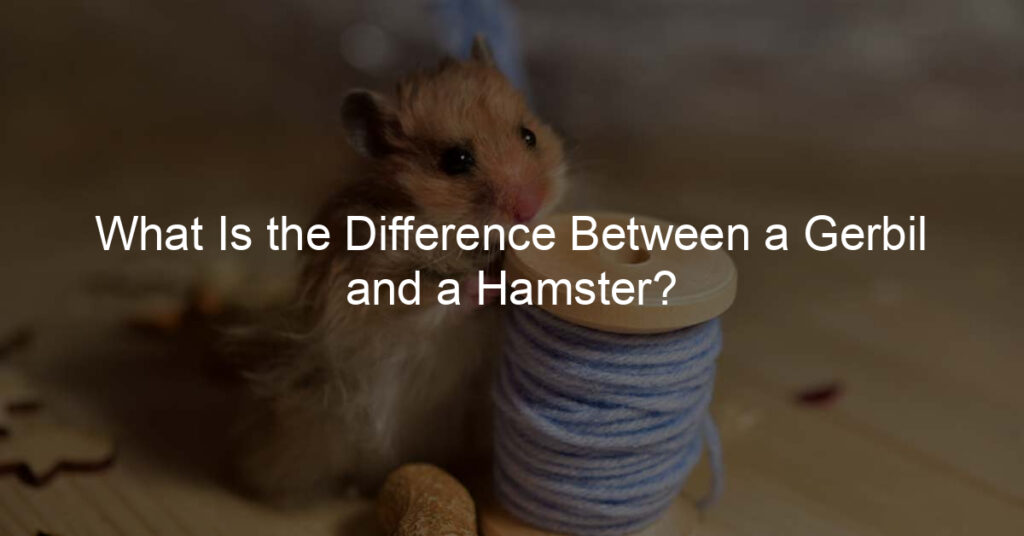Hamsters and gerbils are largely used as pets in most homes nowadays. They are both small and almost look alike. But what’s the difference between a hamster and a gerbil? However, if you look at them keenly, you will notice their different features.
Though hamsters and gerbils share similar features and qualities, it’s equally important to know some of their common differences. So, in this article, we will discuss their differences so you can easily differentiate them.
Let’s get started!
Summary: Differences Between a Hamster and a Gerbil
| Hamster | Gerbil | |
| Physical differences |
|
|
| Lifespan | 1-2 years | 3-5 years |
| Temperament |
|
|
| Diet |
|
|
| Handling | Wear gloves or use a towel when handling them | No need for protecting yourself when handling them |
| Color | Dark stripe to the middle of their back | Dark patches on their head |
1. Physical Differences

There is no doubt that hamsters and gerbils are small in size and can even fit in the palm of your hand. However, there are some noticeable differences in their physical appearance. Hamsters have short and stubby tails that are one inch less. Where else, gerbils have long, hairy tails four inches long.
Another physical difference is their bodies. Hamsters have short and round bodies and often look like fluff balls. They also have short legs. Gerbils have lean, long bodies, large feet, and long hind legs, making them extremely agile.
In addition, hamsters and gerbils also differ in their facial appearance. Hamsters have round, short faces, cheek pouches, and blunt noses. The pouches extend to their shoulders, and they use them as pockets to carry food. Additionally, gerbils have narrow faces and long noses.
2. Lifespan
Another difference between a hamster and a gerbil is their lifespan. Unfortunately, they both don’t live long, but with proper care, they can live a healthy and happy life. Hamsters have a lifespan of 1-2 years, while gerbils have 3-5 years.
Although in rare cases, hamsters and gerbils have lived a little beyond their lifespan. So, giving them the best would be very rewarding, considering their short lifespan.
3. Temperament
Temperament is another key difference between hamsters and gerbils. Hamsters are nocturnal mammals meaning they are usually active at night.
They are also solitary mammals hence don’t like to share their space and would fight other pets who invade their territory. They also bite, especially when hungry, but despite all this, they are very friendly to humans.
On the other hand, gerbils are usually active during the day. Unlike hamsters, gerbils love to stay in pairs or groups. They are also active and friendly. However, they do not bite when handling them; hence they are good pets for children.
4. Diet

While a healthy diet is important for the general health of both animals, their diet differs. The protein intake of hamsters and gerbils varies. Hamsters require 18 to 23 percent protein intake, while gerbils require 14 to 15 percent protein.
In addition, hamsters are food hoarders; where they hide some food in their pouches to eat later, and on other hand, gerbils are not food hoarders.
5. Handling
The way you handle these two animals is very important; either when cuddling, playing, or at the veterinarian, they should be handled with care. Hamsters bite a lot, so you can wear gloves or a towel when handling them. However, unlike hamsters, gerbils do not bite when handling them.
6. Color

Hamsters and gerbils come in a variety of colors. Hamsters come in short or long hair but with different colors. Some hamsters may have white, brown, cinnamon, black, and grey colors.
Some hamsters’ fur may contain wavy hair or satin sheen. Others may have white coats around their bellies and dark stripes to the middle of their back.
Gerbils come in soft and dense coats with a variety of colors. Around 40-50 colors and combinations. Some of their colors include grey, white, reddish brown, and tan. Some may have bluff fur at the back of their ears, and others may grow white patches.
Some gerbils also have dark marks on their head.
Final Thoughts
Hamsters and gerbils have many differences, so it’s essential to be able to differentiate each before considering taking them in as a pet.
Knowing and understanding their differences will also help you in their handling and diet. Now that you know their differences, I hope you work towards giving them the best care and attention.








